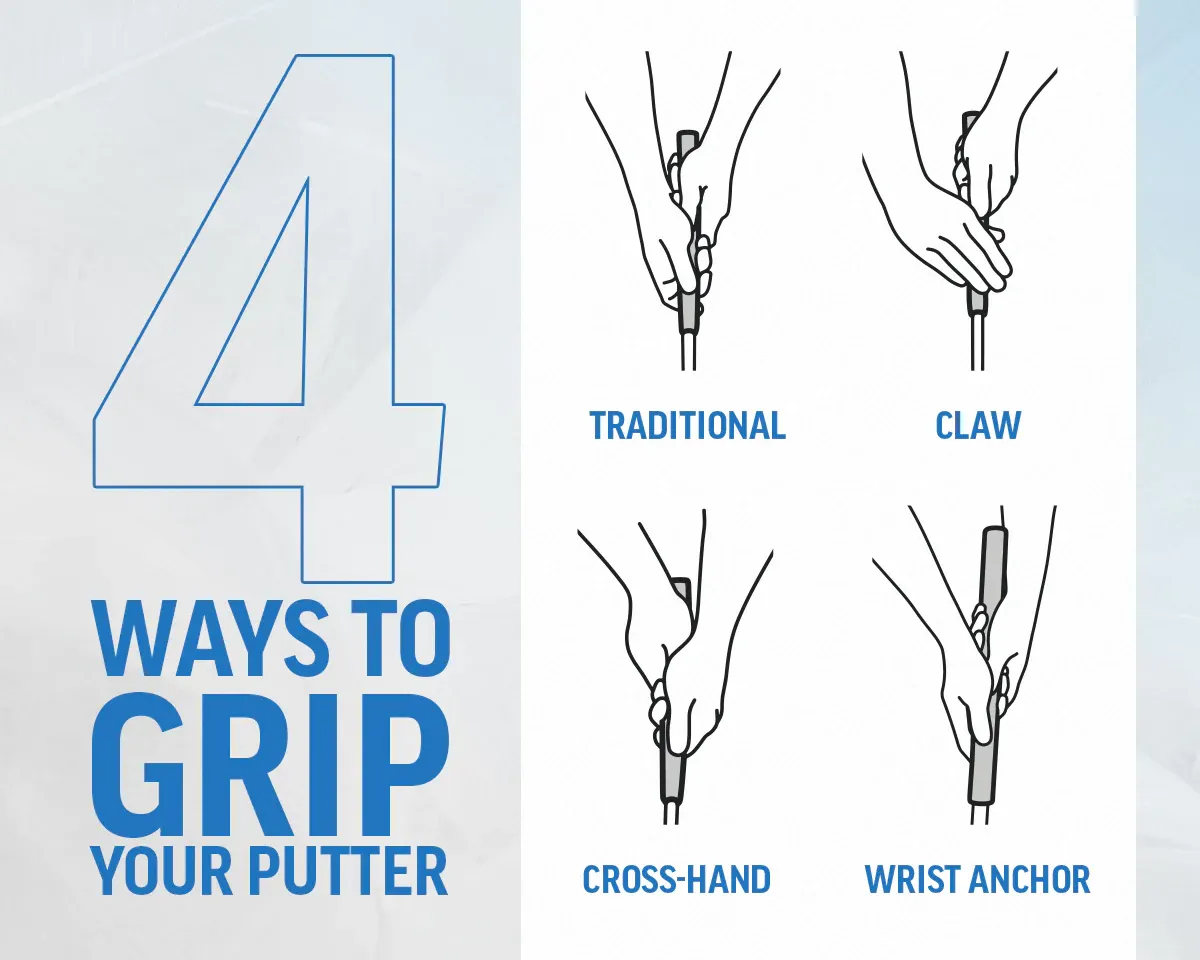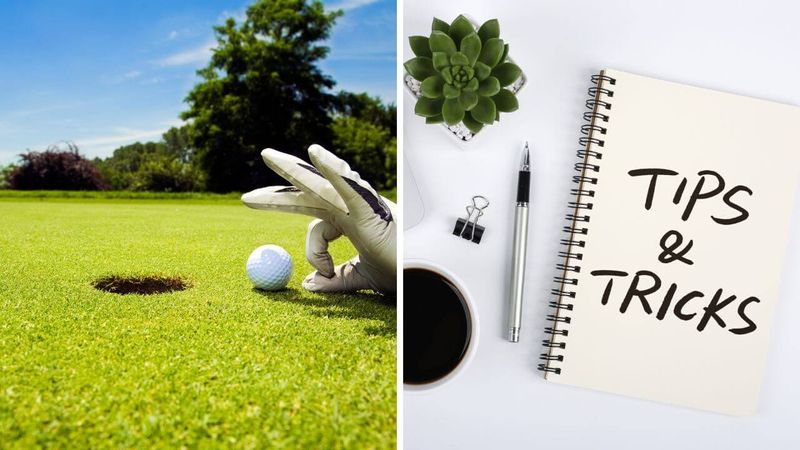Content Summary
Golf Tips for Putting
Putting is a critical aspect of the golf game that most golfers don't realize can make or break your overall score. A solid putting game can save you strokes and lower your handicap. So, it's not just the full swing you have to practice and get good at.
When I finally decided to take the time to understand the nuances of putting and practice it regularly, the effect it had on my golf game was dramatic. My scores dropped by 5 strokes.
Tiger Woods and Phil Mickelson have a great putting stroke because they practice constantly. And they practice the right things. Below we attempt to help you with those right things.

Basic Fundamentals of Putting
Putting is a key part of golf. Knowing the basics can boost your accuracy and score.
Here are 15 essential tips to help you develop a consistent and effective putting routine, enhance your distance control, and ultimately improve your performance on the greens.
1. Develop a putting routine and stick to it…no matter what: Establish a pre-putt routine that helps you feel comfortable and confident over the ball. This routine should include steps like reading the green, visualizing the putt, and taking a few practice strokes. Stick to this routine, regardless of the situation, to maintain consistency under pressure.
2. Think swing length for distance control: Control the distance of your putts by adjusting the length of your backswing and follow-through. A longer swing will generate more power, while a shorter swing will result in less distance. Practice different swing lengths to dial in your distance control.
3. Learn and apply a proper and comfortable putting grip: Find a grip that feels comfortable and provides control without causing tension in your hands or wrists. Common putting grips include the reverse overlap, cross-handed, and the claw grip. Experiment with various grips to determine what works best for you.
4. Head still and listen: Keep your head still throughout the putting stroke to maintain a stable and consistent stroke. Listen for the sound of the ball falling into the hole as a way to stay present and focused on the task at hand.
5. Quiet wrists = more holed putts: Limit wrist movement during your putting stroke to ensure a more stable and consistent stroke. By keeping your wrists quiet, you'll be more likely to make solid contact and hole more putts.
6. Reading the putt: Learn to read the green's slope, grain, and speed to accurately predict the path your putt will take. Take your time to read the putt from multiple angles, and trust your instincts when determining the break.
7. Forget perfection: Accept that you won't make every putt, and focus on the process rather than putting so much emphasis on the outcome. By letting go of the expectation of perfection, you'll be able to stay relaxed and perform more consistently.
8. Listen for the ball to drop in the hole from 10 feet and in: Visualize and listen for the sound of the ball dropping into the hole, especially on putts within 10 feet. This mental cue will help you stay focused on the target and promote a confident stroke.
9. Set up the same way to your putt every time: Consistency is key in putting, so establish a standard setup that works for you. This includes ball position, stance width, and alignment. Use your routine to ensure you're setting up the same way for each putt. Line up your toes, knees, hips, and shoulders with the target. This aids aiming.
10. Think start line for a breaking putt: Focus on starting the ball on the correct line, allowing the green's slope to carry it to the hole. Visualize the path your putt will take and concentrate on initiating your stroke along that line.
11. Create a pendulum putting stroke: Develop a smooth, pendulum-like putting stroke by swinging your arms and shoulders in unison. This type of stroke promotes consistency and solid contact, leading to more accurate putts. Let the putter point to the target after contact with the ball. This keeps your line and avoids any unwanted break.
This is one of the aha moments I had when learning about the putter swing. I was over complicating it.
12. Use putting drills to target your weaknesses: Incorporate putting drills into your practice sessions to address any weaknesses in your game. Common drills include the gate drill, ladder drill, and clock drill. Choose drills that target specific aspects of your putting, such as distance control, accuracy, or green reading.
13. Putt your golf ball over a spot 1-3 inches in front of the ball on your line: To improve your accuracy, select a spot 1-3 inches in front of your ball that lies on your intended line, and aim to roll the ball directly over that spot. This technique helps you focus on a specific target and promotes better alignment and accuracy.
14. Pace & line: Both pace and line are crucial factors in successful putting. While it's important to read the green and select the correct line, it's equally vital to control the speed of your putt. Work on developing a consistent stroke that produces the desired pace, ensuring your putts stay on line and reach the hole.
15. Practice putting with a wedge: Using a wedge for putting practice can help improve your touch and feel on the greens. The additional loft on the wedge requires you to make a more precise stroke to get the ball rolling smoothly. This drill can translate to better control and consistency when using your putter.
A Deeper Dive Into Grip and Posture
Grip and posture are a must for better golf putting
- The grip: Just like for your normal golf swing, finding the right grip is essential for controlling your putter and making consistent strokes. The grip should be comfortable, secure, and promote a smooth, pendulum-like stroke. Here are some common putting grips to consider:
- Reverse Overlap Grip: This is the most traditional grip, where the index finger of your top hand overlaps the pinky finger of your bottom hand. The thumbs should rest flat on the grip, pointing down the shaft.
- Cross-Handed (Left Hand Low) Grip: This grip involves placing your lead hand (left hand for right-handed golfers) below your trail hand on the grip. This grip can help stabilize the wrists and promote a smoother stroke.
- The Claw Grip: In this grip, the top hand holds the putter as usual, while the bottom hand forms a "claw" shape, with the thumb and fingers resting on the grip. This grip reduces wrist action and encourages a more stable stroke.
- The Wrist Anchor: With this grip you can take a traditional grip and a longer putter grip then anchor the grip to your leading wrist.
Experiment with different grips to quickly find the one that feels most comfortable and provides the best control for your putting stroke.

- The posture: Good posture is crucial for maintaining balance and promoting a consistent putting stroke. Here are some key elements to focus on when establishing your putting posture:
- Stand tall and relaxed: Stand close to the ball with your feet shoulder-width apart, and keep your weight centered over the balls of your feet. Your knees should be slightly flexed, and your back should maintain a natural, straight posture.
- Bend from the hips: When addressing the ball, hinge from your hips and allow your arms to hang naturally. This position ensures that your upper body remains stable throughout the stroke.
- Eye position: Your eyes should be directly over the ball or slightly inside the ball-to-target line. This helps you visualize the line of the putt and promotes better alignment.
- Keep your head still: Throughout the putting stroke, it's essential to keep your head still to maintain a consistent stroke and make solid contact with the ball. Focus on a spot on the ball and avoid lifting your head until the ball has rolled away.
Aim and Alignment
Golf putting relies heavily on aim and alignment. Here are some tips to help you improve:
- Visualize your putt path.
- Use a target spot a few inches away from the ball.
- Check your feet, hips, and shoulders are parallel to the target line.
- Adjust your stance if need be.
- Practice regularly.
Small adjustments count for a lot. Keep practicing and find what works for you. Take time to practice on the golf course practice green you will be playing to get a feel for their greens.
Pre-shot Routine
A Pre-shot routine is a must-have to master golf putting.
It helps a golfer stay focused and consistent, leading to more successful putts. Follow this routine:
- Look at the putt - stand behind the ball and check the slope, distance to the hole, and any obstacles.
- Choose a line - pick a target and imagine the ball going along it.
- Stance - make sure your feet are shoulder-width apart and parallel to the target line. Remember the target line is not the line to the hole but the line the ball should start on.
- Square the putter face - make sure the putter face is square to the ball and the intended line (see #3 above).
- Practice swings - mimic the swing and speed in practice swings before the actual putt.
- Concentrate - take a deep breath and focus only on the putt.
Putter Selection
Choosing the right putter is key to putting success.
Here's how:
- Select a putter head design - mallet, blade, or center-shafted.
- Think about the head weight - heavier ones are steadier and better for long shots.
- Check the shaft length and material - longer shafts give better control, while shorter ones provide more accuracy.
- Test the grip - make sure it's comfortable and gives you enough traction.
- Pick one that suits your stance and style.
- Get professional help in choosing the right putter for you.
Putting Tip Drills
To lower your score on the greens, you need to practice your putting technique and incorporate proper putting drills.
Here are 3 drills to help you master it:
- Clock Drill: Place 6 balls around the hole equally, like a clock. Start with short putts. Putt each ball into the hole from each spot. If you miss a putt, start over until you can make all 6 putts in a row. Then move the distance out a bit for the next round and the next.
- Gate Drill: Put two tees in the ground. They should form a "gate" wider than your putter. Then practice putting through the gate.
- The 3-6-9 Drill: Place balls at 3 feet, 6 feet and 9 feet away from the hole. If you miss a putt start over until you can putt each ball into the hole from each distance.
Remember, every putt starts out on a straight line. Doing these drills will help you get a consistent and effective putting stroke. This leads to better performance on the greens.
Mental Strategies for Putting
Putting is essential for golfers. To perfect it, you need practice and mental strategies.
Try these mental techniques to boost your putting game:
- Visualize the ball's path to the hole.
- Focus on the target, not the mechanics.
- Relax and breathe. Don't worry about missing the putt.
- Stay positive. Encourage yourself and trust you can do it.
- Have a pre-shot routine. It will help calm your nerves.
Golf Putting Tips Summary
- Develop a putting routine and stick to it…no matter what
- Think swing length for distance control
- Learn and apply a proper and comfortable putting grip
- Head still and listen
- Quiet wrists = more holed putts
- Reading the putt
- Forget perfection
- Listen for the ball to drop in the hole from 10 feet and in
- Set up the same way to your putt every time
- Think start line for breaking putts
- Create a pendulum putting stroke
- Use putting drills to target your weaknesses
- Putt your golf ball over a spot 1-3 inches in front of the ball on your line
- Pace & line
- Practice putting with a wedge
Conclusion
Improving your putting game requires a combination of practice, consistency, and a strong mental approach.
By incorporating these 15 essential tips into your practice routine, you can develop better distance control, accuracy, and confidence on the greens.
Remember, the key to successful putting is focusing on the process and remaining committed to your routine, regardless of the outcome.






